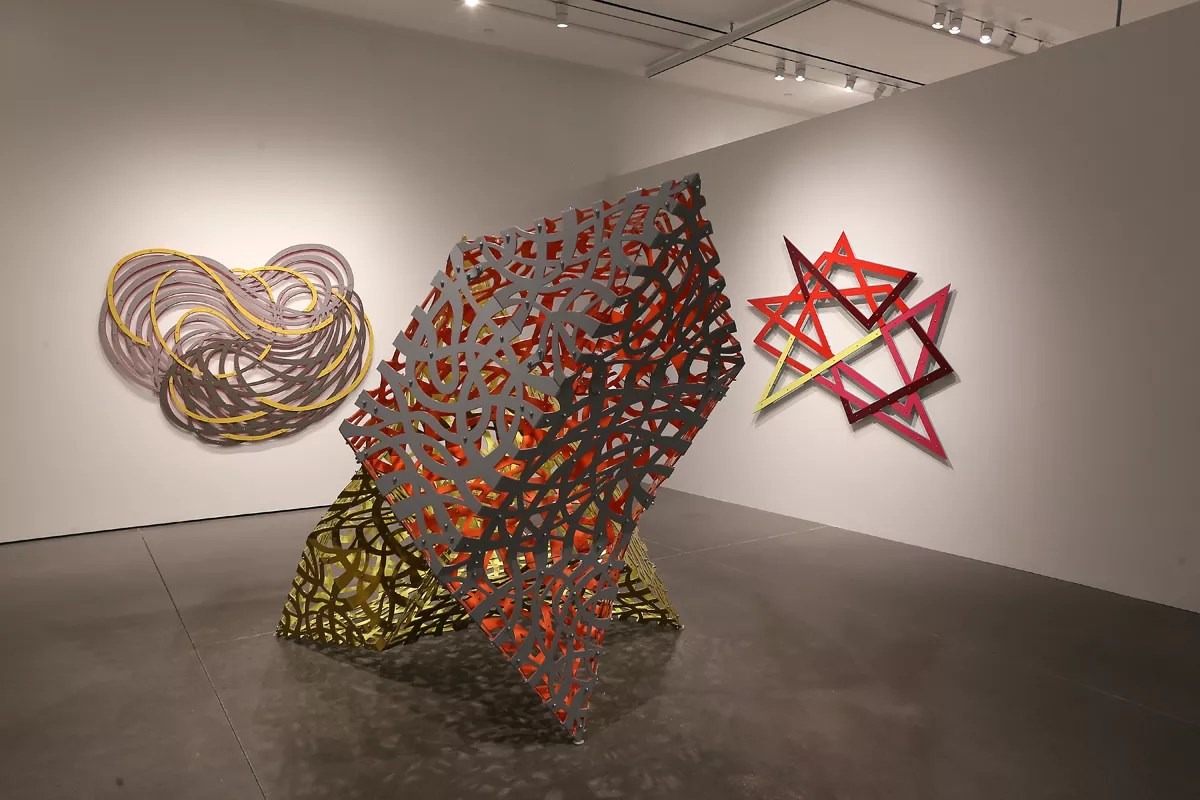
Courtesy of UCCS Galleries of Contemporary Art

Audio By Carbonatix
Southern Colorado and northern New Mexico have a special resonance because of the many artists associated with the region, creating distinctive traditional, modern and contemporary works. Now Colorado Springs, the northernmost outpost of the bifurcated area, is hosting major shows dedicated to two important artists – one with Colorado connections, the other from New Mexico.
Though still in its inaugural year, the Marie Walsh Sharpe Gallery at the Ent Center for the Arts has set a high standard for exhibits. This is thanks to director and curator Daisy McGowan, whose latest effort, Confluence: Linda Fleming, gives another boost to the fine reputation that she’s building for the Ent. Linda Fleming only lives in Colorado part of the year, but she has a studio here. Back in 1968, she was living in New York, working as an artist, when she married fellow artist Dean Fleming. That same year, the couple moved to Colorado, where they helped found the Libre artist community, located on 350 acres outside of Walsenburg. Inspired by the famous Drop City near Trinidad, Libre’s founders were able to avoid the pitfalls encountered by that earlier art commune. At Libre, using plans drawn up by Drop City founder Clark Richert, the Flemings built a forty-feet-in-diameter geodesic dome that served as their home and studios. (Today, Drop City is only a memory, all of its buildings gone, but Libre is still an active artist community, as shown in Radical, an exhibit at GOCA Downtown, the off-campus gallery of the University of Colorado Colorado Springs.)
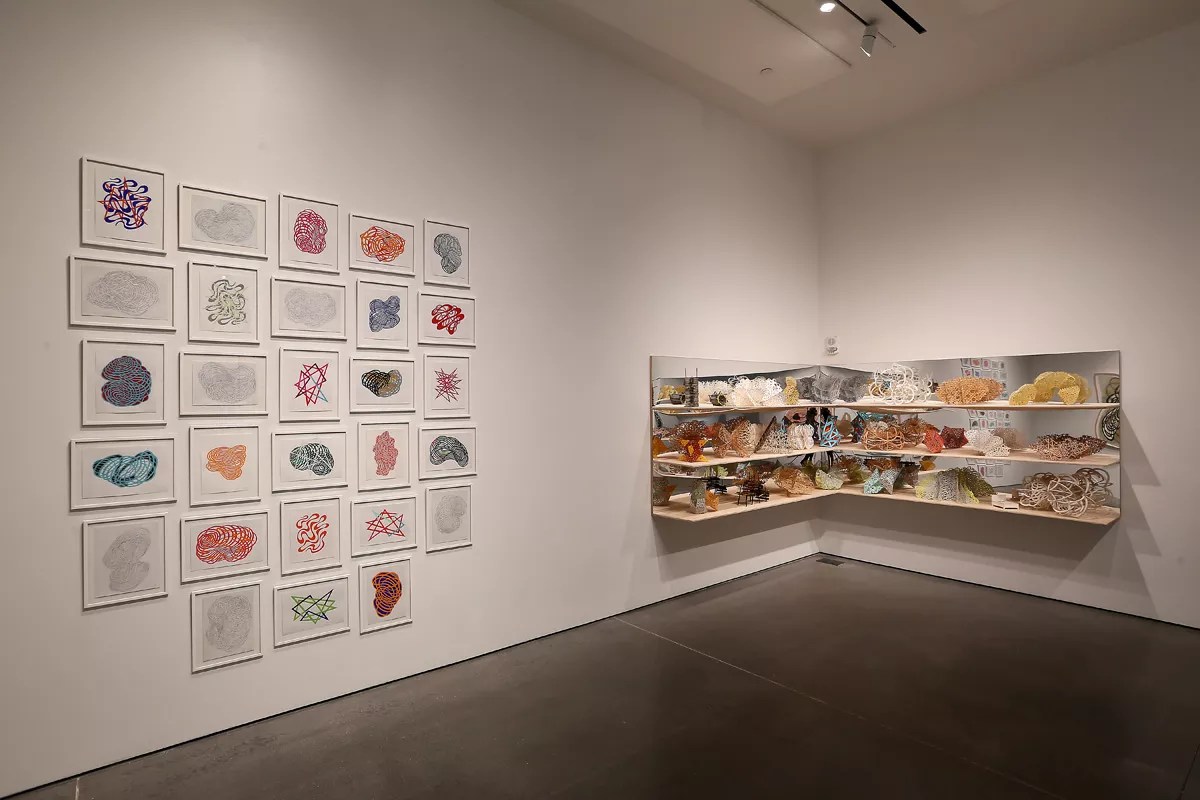
Drawings and maquettes in Confluence: Linda Fleming.
Courtesy of UCCS Galleries of Contemporary Art
The Fleming show is not a retrospective of her long career, but instead is made up almost entirely of recent pieces. There are some historic references, however, notably in the section installed in the corridor just outside the gallery proper, where the walls are covered with digital photos of early Libre, along with a large selection of images of Fleming’s monumental sculptures installed around the country over the years. There’s also the remnant of a wooden and clay sculpture that was once at Libre but is now a very fragile, weathered set of components – though how it originally appeared in the landscape is seen in one of those photos on the wall.
Will you step up to support Westword this year?
At Westword, we’re small and scrappy — and we make the most of every dollar from our supporters. Right now, we’re $22,000 away from reaching our December 31 goal of $50,000. If you’ve ever learned something new, stayed informed, or felt more connected because of Westword, now’s the time to give back.
The exhibit itself includes a number of signature Fleming pieces, which will be familiar to those who’ve seen her work at Robischon Gallery. A pair of complex floor sculptures have been assembled from powder-coated sheets of metal pierced with patterns. In one, and in some wall pieces, Fleming has sandwiched two different-colored sheets together to represent single planes, creating a really neat effect, almost like the look of hard candy. Another classic Fleming type is conveyed by the group of mirror-finished panels that have been cut into grills mounted on the wall; the voids in the panels have flowing shapes. Curator McGowan points out that while these pieces have an industrial quality in terms of their materials, the compositions come out of the natural environment – not just around Libre, but also at Fleming’s studios in Nevada and California.
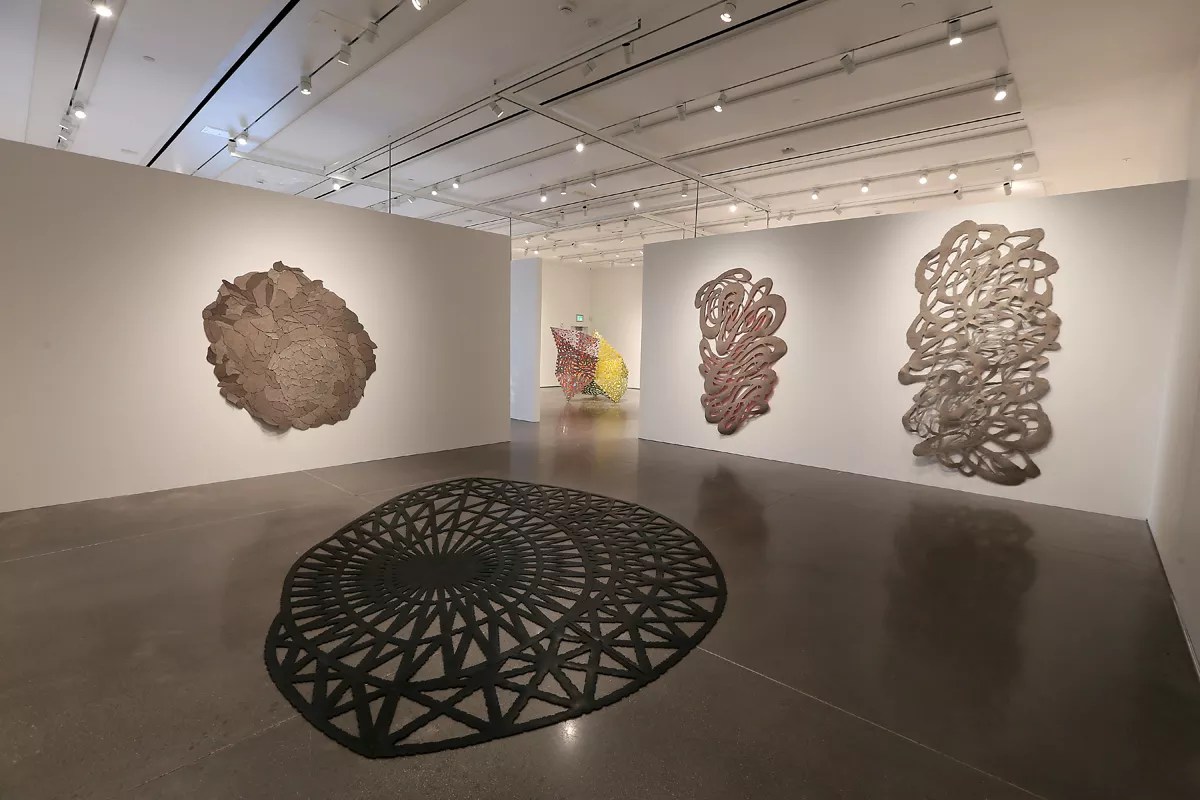
Felt wall sculptures and a rubber floor piece by Linda Fleming.
Courtesy of UCCS Galleries of Contemporary Art
Confluence has some surprises, too. One gallery features Fleming’s patterns done in felt and rubber rather than metal. Another space holds works on paper, in which Fleming’s simple arrangements of shapes become graphic symbols. The whole show is dazzling, but the piece with the most charisma is the set of shelves in the corner, backed by mirrors, that holds a score or more of Fleming’s tiny maquettes for her monumental sculptures. The selection includes not just her recent pierced-metal work, but also examples from her earlier arte povera period, in which she used logs and ropes and found materials.
Also displaying a regional Southwestern vibe is Revolution: Virgil Ortiz, at the Colorado Springs Fine Arts Center. Virgil Ortiz is a Native American artist who lives in New Mexico; his work was shown at the Denver Art Museum in 2015, and he has since been represented by the William Havu Gallery. The CSFAC exhibit, curated by Joy Armstrong, is rooted in the same ideas as those in the DAM show.
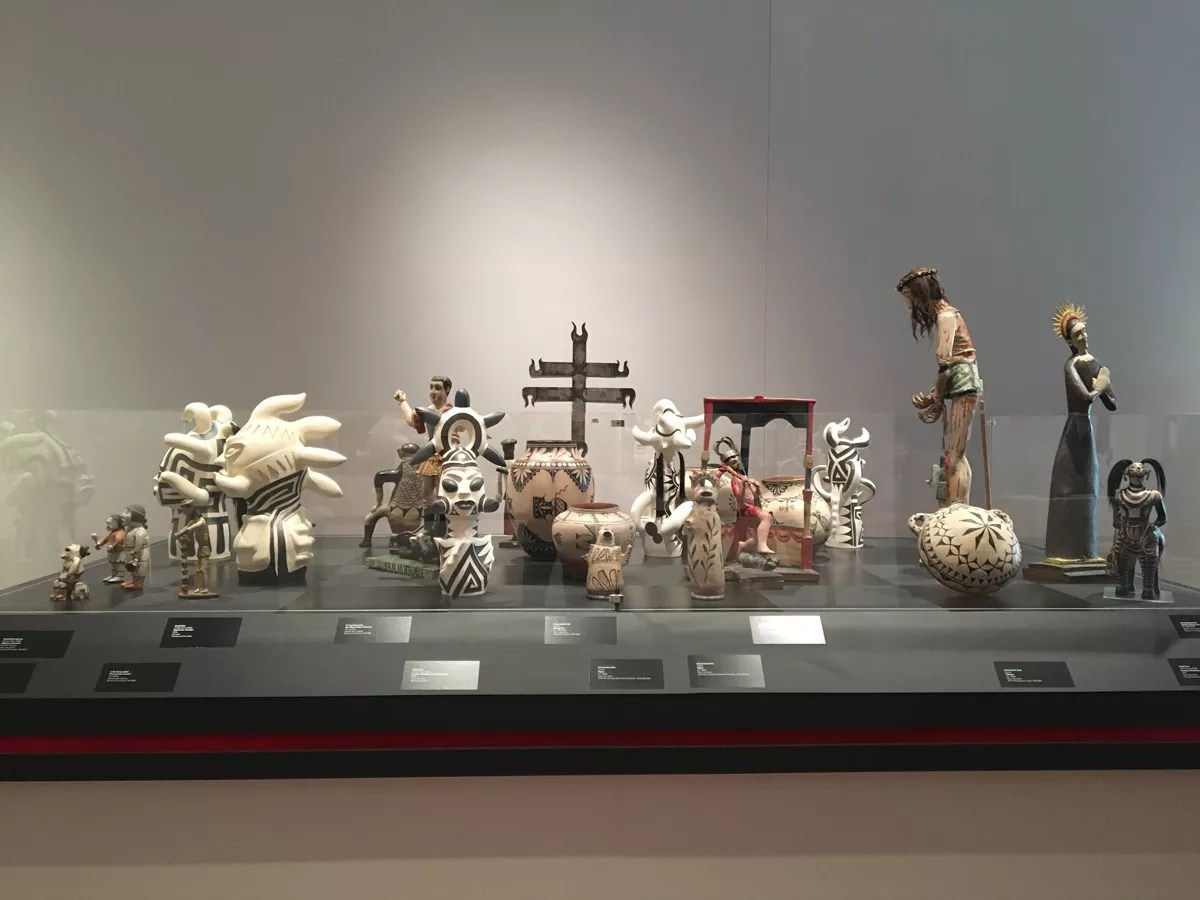
Virgil Ortiz sculptures set among antique Native American and Spanish colonial objects at the Colorado Springs Fine Arts Center.
Robert Delaney
Ortiz is the heir to a multi-generational tradition of potters based in the Cochiti Pueblo, where he grew up. Cochiti is renowned for its pottery, both vessels and figural pieces, but Ortiz does not use traditional Cochiti forms. Instead, he takes the archetypes and morphs them into sci-fi or other fantasy artifacts, interpreted through the age-old Cochiti clay vocabulary. The show’s title, Revolution, refers to the Pueblo Revolt of 1680, in which the indigenous Pueblo people ran off the colonial Spanish, who would return a dozen years later. This is the storyline at the center of Ortiz’s work, which includes not just ceramics, but a full array of mediums including photography, video, costume design and art glass.
The CSFAC’s collection of American Indian and Latino art is among its greatest treasures. Ortiz, whose residency at the CSFAC at Colorado College coincides with this show, wanted to tap that collection and put his work in its context; he accessed the pieces through Southwestern curator Polly Nordstrand. The exhibit opens with a show-stopping moment in which a large, horizontal plinth covered with historic figures and vessels envelops Ortiz’s distinctly contemporary pieces. There are also showcases in which his outlandish figures, drawing from comic-book imagery, depict outer-space fantasies expressed in the traditional Cochiti aesthetic.
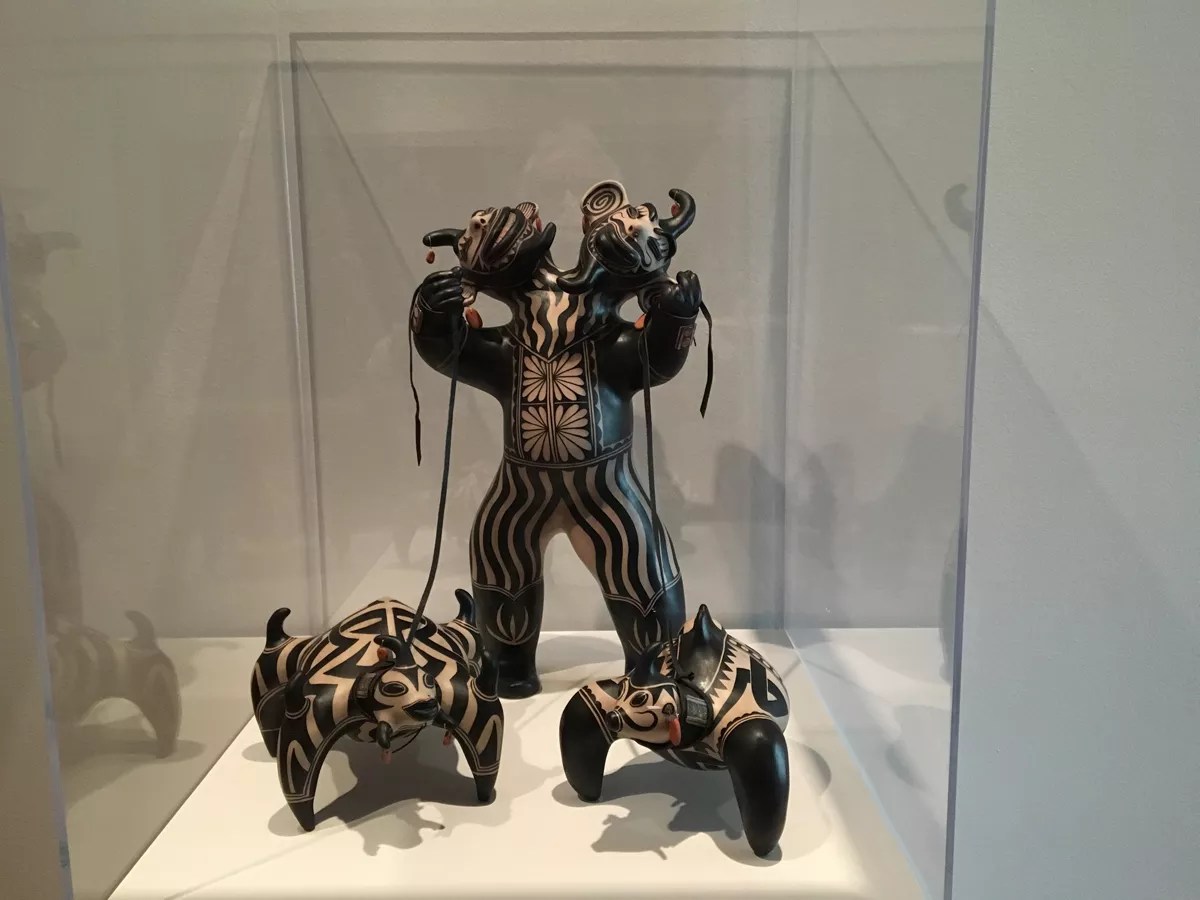
“Master & Tics,” by Virgil Ortiz, clay, glaze and paint.
Robert Delaney
Ortiz’s other mediums are also included, such as the homoerotic yet abstract caryatids done like wallpaper with digital photos on vinyl. Armstrong points out that this imagery is often installed horizontally to represent the landscape, but here it is mounted vertically, like columns. In the central space is a group of mannequins, representing “Aeronauts,” dressed in outfits that Ortiz designed with a post-apocalyptic American Indian look.
The “Aeronauts” – Native warriors from the future – are arranged in front of a vaguely narrative video projection. The most surprising elements of the Ortiz show are displayed in the final gallery: art-glass vessels that sometimes incorporate his familiar ceramics. The impressive glass vases were made during a residency at Corning, where Ortiz worked with Eric Meek and his glass-blowing team.
Driving to Colorado Springs can be a traffic nightmare. But the chance to see two masters of the region, Linda Fleming and Virgil Ortiz, makes it worth the trouble.
Confluence: Linda Fleming, through December 9, Ent Center for the Arts, 1420 Austin Bluffs Parkway, Colorado Springs, 719-255-8227, events.uccs.edu/goca.
Revolution: Virgil Ortiz, through January 6, Colorado Springs Fine Arts Center, 30 West Dale Street, 719-634-5581, csfineartscenter.org.